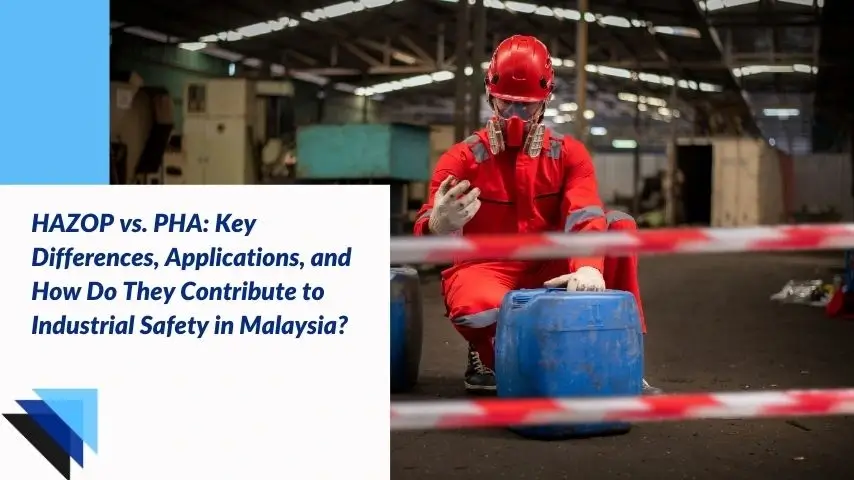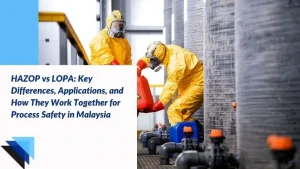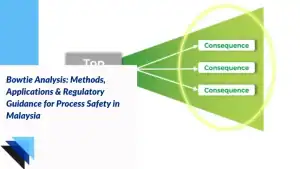Hazard and Operability Study (HAZOP) and Process Hazard Analysis (PHA) are two integral methodologies used in risk assessment and process safety management, particularly in industrial settings. The Process Hazard Analysis (PHA) is a comprehensive methodology for identifying and evaluating potential hazards in industrial processes, while HAZOP (Hazard and Operability Study) is a specific, systematic technique within PHA that focuses on process deviations and their consequences. Understanding these methodologies is vital for:
- Ensuring regulatory compliance
- Preventing industrial accidents
- Implementing effective safety measures
- Optimizing operational efficiency
Whether you’re a safety professional, process engineer, or facility manager, mastering these tools is essential for maintaining safe operations.
In this comprehensive guide, we’ll explore the fundamental differences between HAZOP and PHA, their practical applications, and how they complement each other in creating robust safety frameworks. Let’s dive deep into these critical safety methodologies and learn how they can enhance your facility’s safety performance.
Ensure Safety in Your Facility with HAZOP & PHA
Whether you’re in chemicals, manufacturing, or any other high-risk industry, our expert-led HAZOP and PHA studies help identify hazards, mitigate risks, and enhance safety.
- What Is Process Hazard Analysis (PHA)?
- What Is a HAZOP Study and How Is It Conducted?
- How Do HAZOP and PHA Differ?
- What Risk Assessment and Analysis Methods Are Used in HAZOP and PHA?
- What Are the Key Hazard Identification Techniques in Process Safety Management?
- What Are the Key Regulatory Compliance and Standards for HAZOP and PHA?
- What Are the Best Practices for Implementing HAZOP and PHA?
- How Wellkinetics Can Help
What Is Process Hazard Analysis (PHA)?
Process Hazard Analysis (PHA) serves as a cornerstone in process safety management, offering a systematic approach to identifying and evaluating potential hazards in industrial processes. It encompasses various methodologies designed to assess risks and implement effective control measures.
What Are the Core Components of PHA?
PHA involves a thorough examination of process equipment, materials, and operations to identify potential failure points. This systematic evaluation considers chemical reactions, process conditions, and equipment integrity to create a comprehensive safety assessment.
The analysis typically focuses on three key areas:
- Process chemistry and technology
- Equipment and facility design
- Human factors and operational procedures
How Is a PHA Team Structured?
A successful PHA requires a diverse team of experts, including:
- Process engineers
- Safety specialists
- Operations personnel
- Maintenance staff
- Management representatives
Each team member brings unique insights and perspectives, ensuring a thorough evaluation of potential hazards from multiple angles.
What Is the PHA Implementation Process?
The PHA implementation follows a structured approach:
1. Gathering process information and documentation
2. Identifying potential hazard scenarios
3. Evaluating consequences and likelihood
4. Determining risk levels
5. Recommending control measures
6. Documenting findings and action items
This systematic process ensures that no critical safety aspects are overlooked during the analysis.
What Are the Documentation Requirements for PHA?
Proper documentation is crucial for PHA effectiveness. Essential records include:
- Process flow diagrams
- Operating procedures
- Safety system descriptions
- Previous incident reports
- Risk assessment matrices
These documents serve as foundational references for future safety reviews and regulatory compliance.
RELATED: Understanding Process Hazards and How to Effectively Address Them
What Is a HAZOP Study and How Is It Conducted?
The HAZOP study methodology follows a systematic and structured approach to identify potential hazards and operational problems in process systems. It involves a detailed examination of each process component to evaluate possible deviations from design intent.
How Is a HAZOP Team Formed and Prepared?
A successful HAZOP study begins with assembling a qualified multidisciplinary team. This team typically includes process engineers, safety specialists, operators, and maintenance personnel. Each member brings unique insights and expertise to the analysis.
The team reviews process documentation, including P&IDs, operating procedures, and safety systems. This preparation phase ensures all participants understand the process parameters and system boundaries before the actual study begins.
RELATED: How to Conduct a HAZOP Study: A Comprehensive Guide for Malaysian Industries
What Are the Steps in the Systematic HAZOP Review Process?
The HAZOP process divides the system into manageable sections called nodes. Each node represents a specific part of the process where operating conditions might deviate from normal parameters.
The team applies guidewords systematically to each node:
- No/None: Complete absence of the design intention
- More: Quantitative increase in a parameter
- Less: Quantitative decrease in a parameter
- As Well As: Qualitative increase
- Part Of: Qualitative decrease
- Reverse: Logical opposite of the intention
- Other Than: Complete substitution
For each combination of guideword and process parameter, the team:
1. Identifies possible causes of deviation
2. Evaluates potential consequences
3. Reviews existing safeguards
4. Determines if additional controls are needed
5. Documents recommendations and actions
The systematic application of these guidewords helps ensure no potential hazards are overlooked during the analysis. The team documents all findings, including identified hazards, consequences, and recommended actions in a structured format for future reference and implementation.
RELATED: HAZOP in Oil and Gas Industry: How to Prepare, Conduct, and Improve Safety in Malaysia
How Do HAZOP and PHA Differ?
HAZOP and PHA differ significantly in focus, methodology, and application, each serving a unique purpose in the realm of process safety management.
What Are the Key Differences in Scope and Focus?
PHA encompasses a broader spectrum of hazard identification methods, serving as an umbrella term for various risk assessment techniques. It examines potential hazards across entire processes, from raw material handling to final product storage. HAZOP, being a subset of PHA, specifically concentrates on process deviations and their potential consequences within defined system boundaries.
How Do HAZOP and PHA Differ in Their Methodologies?
PHA employs multiple methodologies like What-If Analysis, FMEA, and Fault Tree Analysis to identify hazards. Each method is selected based on the process complexity and risk level. HAZOP follows a more structured approach using predefined guidewords (such as More, Less, No, Reverse) to systematically analyze process parameters and their deviations.
How Does the Team Composition Differ Between HAZOP and PHA?
While both methods require multidisciplinary teams, PHA teams can vary in size and expertise depending on the chosen methodology. HAZOP demands a consistent core team including process engineers, operators, and safety specialists throughout the study. The HAZOP team must maintain continuity to ensure comprehensive deviation analysis.
How Do Documentation Requirements Differ for HAZOP and PHA?
PHA documentation varies based on the selected technique but generally includes hazard identification, risk assessment, and control measures. HAZOP follows a more rigid documentation structure, requiring detailed recording of each node, parameter, deviation, causes, consequences, and safeguards in a standardized format.
When Should HAZOP and PHA Be Conducted?
PHA studies can be conducted at various stages of facility lifecycle, from conceptual design to decommissioning. HAZOP is most effective when performed during the detailed design phase before facility construction, though it can also be valuable during major modifications or periodic reviews.
RELATED: HAZOP vs. HAZID: Key Differences, Applications, and When to Use Each in Malaysia
What Risk Assessment and Analysis Methods Are Used in HAZOP and PHA?
Process safety management relies heavily on systematic approaches to identify and evaluate potential hazards. These methodologies help organizations maintain safety standards and prevent accidents effectively.
1. Qualitative Risk Assessment
Qualitative risk assessment involves evaluating risks based on their likelihood and severity using descriptive terms. This method employs matrices and risk ranking systems to categorize hazards as high, medium, or low risk. Safety professionals often start with qualitative assessment to prioritize which areas need detailed analysis.
2. Quantitative Risk Assessment
This method uses numerical data and statistical analysis to measure risk levels precisely. It involves calculating failure frequencies, consequence modeling, and determining probability distributions. Quantitative assessments provide concrete data for decision-making, especially when evaluating expensive safety measures.
3. Semi-Quantitative Risk Assessment
Semi-quantitative approaches combine elements of both qualitative and quantitative methods. They assign numerical values to qualitative descriptions, creating a more structured analysis while maintaining simplicity. This hybrid approach is particularly useful when complete numerical data isn’t available but more precision than qualitative assessment is needed.
How Does a Risk Matrix Help in Risk Assessment?
Risk matrices serve as visual tools for evaluating and communicating risk levels. They typically plot consequence severity against occurrence likelihood, helping teams:
- Identify high-priority risks requiring immediate attention
- Allocate resources effectively
- Track risk reduction progress
- Communicate risk levels to stakeholders
Why Is Documentation and Regular Review Crucial for Risk Assessments?
Proper documentation of risk assessments is crucial for:
- Maintaining compliance records
- Tracking implementation of control measures
- Supporting future safety reviews
- Demonstrating due diligence to regulators
Regular reviews ensure assessments remain current and effective as processes or conditions change.
What Are the Key Hazard Identification Techniques in Process Safety Management?
Process safety management relies heavily on systematic hazard identification techniques to prevent potential incidents and ensure workplace safety. These techniques form the foundation of comprehensive risk assessment and management strategies.
1. Checklist Analysis
Checklist analysis is one of the simplest yet effective methods for identifying hazards. It involves using pre-developed lists to systematically examine equipment, materials, and procedures for potential safety concerns. This structured approach helps ensure no critical safety aspects are overlooked during the assessment process.
2. What-If Analysis
What-if analysis encourages creative thinking about potential hazards by asking questions like “What if this valve fails?” or “What if pressure exceeds limits?” This brainstorming technique helps teams identify possible deviations and their consequences, leading to more robust safety measures.
3. Failure Modes and Effects Analysis (FMEA)
FMEA is a systematic method that examines each component of a system to identify potential failure modes and their impacts. This technique helps prioritize risks based on severity, occurrence probability, and detection capability, enabling focused preventive actions.
4. Fault Tree Analysis (FTA)
FTA uses a top-down approach to analyze system failures. Starting with an undesired event, it traces backward to identify basic causes using logical relationships. This visual representation helps teams understand complex failure pathways and implement appropriate safeguards.
5. Hazard and Operability Study (HAZOP)
HAZOP systematically evaluates process parameters using guidewords to identify potential deviations. This comprehensive technique examines each process variable, making it particularly effective for complex chemical processes and operations.
What Are the Key Regulatory Compliance and Standards for HAZOP and PHA?
Process safety regulations and standards play a crucial role in ensuring the effective implementation of HAZOP and PHA methodologies. Organizations must comply with various regulatory frameworks to maintain safety standards and prevent potential hazards.
1. OSHA PSM Requirements
The Occupational Safety and Health Administration’s Process Safety Management (PSM) standard mandates regular hazard assessments for facilities handling highly hazardous chemicals. This regulation specifically requires facilities to conduct and document PHAs, including HAZOP studies, at least every five years.
RELATED: The Importance of Process Safety in Handling Hazardous Substances
2. International Standards
Global organizations often follow international standards like ISO 31000 for risk management and IEC 61882 for HAZOP studies. These standards provide structured approaches to hazard identification and risk assessment, ensuring consistency across different regions and industries.
3. Industry-Specific Guidelines
Different industries have their own specific guidelines and best practices. For instance, the chemical industry follows guidelines set by the Center for Chemical Process Safety (CCPS), while the oil and gas sector adheres to standards established by organizations like the American Petroleum Institute (API).
RELATED: Best Practices for Implementing Process Safety Management in the Oil and Gas Industry
4. Documentation Requirements
Regulatory compliance demands thorough documentation of all HAZOP and PHA studies. This includes maintaining detailed records of team compositions, methodology used, findings, recommendations, and follow-up actions taken to address identified hazards.
Ensure Compliance with Industry Standards
Stay compliant with industry regulations and avoid costly fines by incorporating HAZOP and PHA into your safety practices.
What Are the Best Practices for Implementing HAZOP and PHA?
To effectively implement HAZOP and PHA studies, it’s essential to establish best practices that ensure thorough analysis and enhance safety outcomes. Here are several key recommendations:
1. Team Composition and Training
A successful HAZOP or PHA implementation requires a well-structured team with diverse expertise. The team should include process engineers, safety specialists, operators, and maintenance personnel. Regular training sessions ensure team members stay updated with the latest methodologies and industry standards.
2. Documentation and Record Keeping
Maintaining detailed documentation throughout the analysis process is crucial. This includes recording all identified hazards, risk assessments, recommendations, and action items. Implement a robust system for tracking the status of corrective actions and maintaining historical data for future reference.
3. Regular Reviews and Updates
Schedule periodic reviews of existing HAZOP and PHA studies to ensure they remain relevant. Process modifications, equipment changes, or new regulatory requirements may necessitate updates. Establish a systematic approach for reviewing and updating safety analyses at predetermined intervals.
4. Communication and Stakeholder Engagement
Effective communication between team members, management, and stakeholders is essential. Create clear channels for reporting findings and implementing recommendations. Ensure all relevant parties understand their roles and responsibilities in the safety analysis process.
5. Quality Control Measures
Implement quality control checks throughout the analysis process. This includes peer reviews of documentation, verification of data accuracy, and validation of recommended control measures. Regular audits help maintain the integrity of the safety analysis program.
How Wellkinetics Can Help
At Wellkinetics, we understand the complexities and challenges of maintaining a safe operational environment. Our expert team is dedicated to helping organizations navigate the demanding landscape of hazard assessments and regulatory compliance. Here’s how we can assist in your journey towards enhanced process safety:
1. Tailored solutions for your facility
We believe that every facility is unique, requiring customized solutions that align with your specific operational needs. Our team will conduct a comprehensive assessment of your current processes, identifying areas where HAZOP and PHA methodologies can be effectively applied. We leverage our extensive industry knowledge to develop strategies that minimize risks and enhance safety protocols, tailored to your facility’s requirements.
2. Expert training and support
Our professional training programs ensure that your team remains competent and confident in executing HAZOP and PHA studies. We provide hands-on training sessions, workshops, and ongoing support to empower staff at all levels. This commitment not only strengthens your team’s capability but also fosters a culture of safety within your organization.
3. Thorough documentation and analysis
We assist in establishing robust documentation practices that capture every detail of your HAZOP and PHA activities. Our experienced consultants ensure that all findings, recommendations, and actions taken are meticulously recorded, creating a solid foundation for future reference and compliance. With our help, you’ll eliminate the stress of regulatory audits and inspections, knowing your records are thorough and precise.
4. Proactive risk management strategies
At Wellkinetics, we not only focus on identifying existing hazards but also on anticipating potential risks before they materialize. Our approach involves conducting thorough risk assessments and scenario analyses that highlight vulnerabilities within your processes. By implementing proactive risk management strategies, we help you build a resilient operational framework that minimizes risk exposure and enhances overall safety performance.
5. Continuous improvement and feedback loops
Safety is not a one-time achievement but an ongoing commitment. We emphasize the importance of continuous improvement in your safety management practices. Our team establishes feedback loops that monitor the effectiveness of implemented control measures and encourage regular communication between stakeholders. This ongoing process helps you refine safety protocols and adapt to changes within your operational environment, ensuring sustained compliance and enhanced safety culture.
6. Regulatory compliance navigation
Understanding and adhering to regulatory standards can be daunting. At Wellkinetics, our expertise in regulatory compliance simplifies this process for you. We stay abreast of the latest industry regulations and guidelines, providing your organization with the clarity needed to remain compliant. Our team will guide you through the intricacies of applicable laws and help you establish procedures that not only meet but exceed regulatory requirements, thus reducing the likelihood of non-compliance penalties.
Learn more about our Process Safety Consultancy Services.




